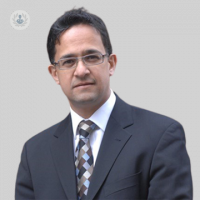What is facial paralysis?
Escrito por:Your facial movements are controlled on each side by the facial nerve emerging onto the face below the ear from the base of the skull and branching out to the facial muscles, acting like an orchestra’s conductor to control and instruct the facial muscles to move in coordination. Hence, in normal situations where the facial nerves (the conductor), and the muscles (the orchestra), are playing well together then facial movements will appear normal and coordinated. If the facial nerves are not working properly, then facial imbalance and a loss of control in the way the face moves will result. This can be very troubling and challenging to live with. Mr Jonathan Britto, a leading plastic surgeon, discusses what causes facial paralysis and how it can be treated.
There are different types of facial paralysis, all of which I treat, but it is important to note that cases of facial paralysis must be treated within a multi-disciplinary team with an outlook of comprehensive care. That means that plastic surgeons, ENTs, neurologists, ophthalmologists and psychologists will treat patients together, as lots of different elements will be at play. For example, facial paralysis may affect the eyelids and how well they open and close to protect the eye and vision, which of course is something an ophthalmologist will consult on.
What can cause facial paralysis?
Facial paralysis can result from birth (congenital facial paralysis), affecting young children. In such cases, either the development of the facial nerves or the facial muscles is incomplete or impaired. As a result there is no coordinated facial movement. An example of a congenital condition that causes facial paralysis is what’s known as Moebius syndrome. This is a very rare condition that results in bilateral facial paralysis.
In adults, the most common cause of facial paralysis is Bell’s palsy, which arises as a consequence of a viral infection which affects the facial nerve function. This condition will frequently start with a tingling sensation in the face, and over a 24-48 hour period, partial or total facial paralysis will result. This can be a very frightening experience for patients and must be treated as an emergency as early treatment has been found to aid early recovery and reduce the adverse impact. In Bell’s palsy, facial nerve function and facial movement may return to normal, and early steroid therapy accelerates recovery. During this recovery phase, supportive therapies such as specialised facial physiotherapy and Botox therapy can help to manage the challenges of facial asymmetry and loss of coordinated movement which can cause patients much psychological stress and loss of confidence.
Facial paralysis in adults can also result from either trauma or invasive cancers, particularly those that affect the base of the skull. Therefore, tumours found here or injuries to the base of the skull are more likely to result in permanent damage to the facial nerve on that side, and loss of coordinated facial muscle movement on that side of the face. Tumours or injuries that affect the nerves further away from the facial nerve root (the base of the skull) are more likely to produce localised and peripheral damage in the face. For example, those that affect the forehead will result in brow paralysis, invasive tumours of the temple may affect the brow and eyelid function on that side of the face.
What risks factors are associated with facial paralysis?
- Pregnancy
- Viral infection
- Tumours
- Head and neck injuries
- Congenital conditions (from birth)
How can facial paralysis be treated?
A combination of symptomatic treatments are available, meaning treatment depends on which branches of the facial nerve are affected. For example, we are unable to reanimate a paralysed brow, however, by lifting the brow surgically we can provide symmetry and unload the upper eyelids.
If the eyelids are affected by paralysis, often the eye surface won’t be properly protected, but by re-positioning the eyelids with surgery we can allow the lids to close properly, protecting the eyes. If the lower lids are affected, they may become lax and unsupported - then by re-positioning and supporting them surgically them we can provide protective eyelid closure.
If the lower face is affected, there are a range of techniques that can lift and support the lower face, improving speech and breathing capabilities. We are also able to bring in new muscles, using microsurgery techniques which are connected and powered by new nerves. These techniques allow facial reanimation.
Children who are affected by facial paralysis will often be surgically treated between the ages of 7-10 to achieve facial reanimation in this way.
Supportive treatments for facial paralysis
It is important to understand that whilst surgery can help to reanimate and lift parts of the face affected by paralysis, there are additional therapies needed to achieve a complete and comprehensive treatment plan. The following will often be used in support of surgery:
- Speech therapy – this can help patients learn to speak better and learn coping mechanisms.
- Botox therapy – accurate use of Botox can help to improve facial symmetry.
- Psychological support – living with facial paralysis can be challenging physically and mentally and can take a real toll on your confidence and quality of life. Psychological techniques in combination with surgery add value to build confidence
- Techniques of facial aesthetic surgery – can be life changing to build confidence
Whilst living with facial paralysis can be challenging, with the support of a multi-disciplinary team working toward best outcome with comprehensive care, there are treatments and therapies that can make a huge difference to those affected.
If you are or a loved one are affected by facial paralysis and you would like to see a specialist, make an appointment with an expert.



